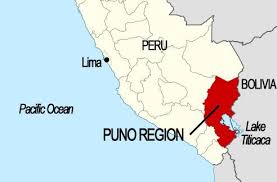From Peru we heard that the National Institute for the Defense of Competition and Protection of Intellectual Property (INDECOPI) is raising awareness about the implementation of collective marks and appellations of origin. This month, a talk was given to members of the Technical Bureau of ‘Quinoa’ in the ‘Puno Region’. [According to tripadvisor, "some of the 362 varieties of quinoa" grow in the Puno Region, Peru.]

The aim is to boost the collective mark ‘Aynok’ which was registered within the INDECOPI to distinguish processed quinoa. Yet, this is an ongoing technical advice to producers of quinoa from the Puno Region, so they “can obtain certification of organic products”.
The event is part of the framework of the 'Dissemination strategy and advocacy for Distinctive Signs - Strategic alliances with public and private organizations linked to the productive sectors'. Basically this agenda, developed by INDECOPI, aims to publicize the benefits that a sign may bring to the distinctiveness of a brand or a product, by labeling the place from which it originates.
 INDECOPI reports that they are exploring “the feasibility of achieving the protection of a designation of origin for quinoa, in coordination with the "Budget Program PP 0035", carried out by the Regional Government Puno.”
INDECOPI reports that they are exploring “the feasibility of achieving the protection of a designation of origin for quinoa, in coordination with the "Budget Program PP 0035", carried out by the Regional Government Puno.”
INDECOPI acknowledges that there are many other bodies (such as “Ministry of Trade and Tourism (Mincetur), PromPeru, the Ministry of Environment (Minam), the International Trade Centre (ITC) and the Joint Andean Grains Program of the Office of the International Labour Organisation for Andean Countries”) which are participating and supporting the development of a distinctive sign for quinoa in the Puno Region.
Source INDECOPI.
The aim is to boost the collective mark ‘Aynok’ which was registered within the INDECOPI to distinguish processed quinoa. Yet, this is an ongoing technical advice to producers of quinoa from the Puno Region, so they “can obtain certification of organic products”.
The event is part of the framework of the 'Dissemination strategy and advocacy for Distinctive Signs - Strategic alliances with public and private organizations linked to the productive sectors'. Basically this agenda, developed by INDECOPI, aims to publicize the benefits that a sign may bring to the distinctiveness of a brand or a product, by labeling the place from which it originates.
INDECOPI acknowledges that there are many other bodies (such as “Ministry of Trade and Tourism (Mincetur), PromPeru, the Ministry of Environment (Minam), the International Trade Centre (ITC) and the Joint Andean Grains Program of the Office of the International Labour Organisation for Andean Countries”) which are participating and supporting the development of a distinctive sign for quinoa in the Puno Region.
Source INDECOPI.